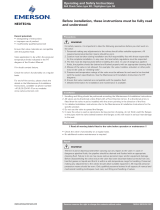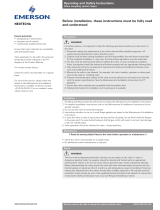Page is loading ...

SEMPELL DEWRANCE GATE VALVES
Operating and safety instructiOns
OPERATING AND ROUTINE MAINTENANCE
!! Read all warning labels fitted to the valve
beforeoperation or maintenance!!
STORAGE / PROTECTION / SELECTION
State of delivery
Our valves are delivered with protection
according to customer’s specification, or in
accordance with the standard Quality Control
Plan. To protect the valve end from damage
wrapping and/or covers should be left in place
until immediately before fitting to the pipe.
Storage
When the valves are to be stored for some time
before being fitted, storage should be in the
original delivery crates with any waterproof
lining and/or desiccant remaining in place.
Storage should be off the ground in a clean,
dry,indoor area.
If storage is for a period exceeding six months
the desiccant bags (if supplied) should be
changed at this interval. If valves are stored for
longer than 12 months our personnel should
inspect them before installation whenever
feasible or practical.
Selection
Ensure the materials of construction of the
valve and pressure/temperature limits shown
on the identification plate are suitable for the
process fluid and conditions. If in doubt contact
supplier.
Limitations
• Do not use valve for end-of-line function. Std
safety practice requires in all instances at the
end of pipe 2 valves or one valve plus blind
flange.
• Do not use open/close valves for regulating
duties.
• Do not use process valves as stop valves for
flushing.
• Suggested allowable max pipeline flow
velocity is:
6m/s for liquid
80m/s for gas or steam
Before installation these instructions must be fully read and understood
VCOSI-01406-EN 15/05
Operation
Our valves are operated manually,
automatically or by an external operator
(Electric/Pneumatic/Hydraulic).
All handwheel operated valves, including valves
operated by electric actuator, are “clockwise
to close” The position open/close is indicated
by a position indicator on valve (if fitted) as well
as the indicator arrow on the electric actuator
(if fitted). Actuator torque/travel switches are
set at the factory prior to shipment. These
must be checked prior to operation according
the actuator sizing sheet (if applicable) and
actuator instructions. Torque settings must not
be altered. Actuator "Torque Switches" should
not be used on Parallel Slide Gate Valves. Do
not use additional force, for example the use of
wrench on the handwheel, to operate a valve.
During start-up of the plant check gland
packing and bonnet flange bolts.
Maintenance
If valves are fitted with grease nipples then
grease should be applied at 3 month intervals.
Exposed, threaded, operating stems should
have grease applied at similar intervals.
Lubricate any actuators, gearboxes according
to individual manufacturer instructions.
No other routine maintenance is required other
than periodic inspection to ensure satisfactory
operation and sealing. Any sign of leakage
from the gland packing should be addressed
immediately by depressurizing the valve and
tightening the gland screws gradually and
evenly.
If no further adjustment is possible or seat
leakage is suspected, the valve will require
a complete overhaul. This should be carried
out after depressurisation and in accordance
with the relevant maintenance instruction.
Itisstrongly recommended to use only
originalspares.
Spare parts
Our valves are identified by a serial number,
which is stamped on the identification plate.
This reference should be quoted in respect of
any after sales queries, spare parts or repair
enquiries/orders. The valve may be lifted only
by slings attached to the flange holes or valve
body; never to the actuator or the valve opening.
www.valves.emerson.com © 2017 Emerson. All rights reserved.

2
SEMPELL DEWRANCE GATE VALVES
Operating and safety instructiOns
INSTALLATION
WARNING!
For safety reasons, it is important to take the
following precautions before you start work
onthevalve:
1. Read all labels fitted to the valve and this
sheet before installation, operation and
maintenance.
2. Use valves only for the intended purpose
(according contract).
3. Additional mounting/modifications on valves
are not allowed without approval from our
technical department.
4. Personnel making any adjustments to the
valve should utilize equipment and clothing
normally used to work with the process where
the valve is installed.
5. The line must be depressurized, drained,
vented and cooled down before installing
thevalve.
6. Handling of all valves, operators and actuators
must be carried out by personnel trained in all
aspects of manual and mechanical handling/
lifting techniques, if applicable follow lifting
procedures.
7. Ensure the valve pressure/temperature
limitations marked on the identification label
are above or equal to service conditions.
8. It is possible, in some valve designs, for sealed
cavities within the valve body to be filled
with liquid, for example during hydrostatic
test. If this liquid is not released, by partially
opening the valve or some other means,
and it is subject to a temperature increase;
excessive pressure sufficient to cause
pressure boundary failure can be generated.
Where such a condition is possible, it is the
responsibility of the purchaser to provide,
or require to be provided, means in design,
installation, or operating procedure to assure
that the pressure in the valve will note
exceed that allowed by the pressure rating
ofthevalve.
9. Check correct electric connection of actuator
if any, wrong connection may be cause danger
and heavily damage the valve.
10. If the actuator is required to reposition on
the valve, it is necessary after this operation
recalibrate the limit switches (this operation
is described in the actuator maintenance
manual). Non calibrated actuators are a cause
of danger and may cause irreparable damage
to the valve.
1. Our valves are bi-directional unless fitted
with a Flow Direction Arrow. If a directional
arrow is fitted then the valve must be
installed with the arrow pointing in the
direction of the flow (and/or pressure, refer
to the general arrangement drawing).
2. Unless specifically stated on the General
Arrangement Drawing, installation may be
carried out with stem displaced vertical-
upwards through horizontal.
3. In case of horizontal and vertical pipelines
the valve cover / stem must be uppermost.
4. Remove protective covers from valve end
faces and any transport-protection applied
to the valve stem (if applicable).
5. It is responsibility of the customer to
arrange extra support if necessary for
thevalves.
6. For flanged valves ensure that mating
flanges and gaskets are clean and
undamaged. Forbuttweld valves ensure
that the weld profile is clean and in
suitablecondition for welding.
7. Should there be any possibility of abrasive
particles (weld slag, sand, chemical
cleaning residue etc.) within the piping
system, this could damage valve seating.
The system needs to be thoroughly
flushedand cleaned prior to operation.
8. If valve ends are flanged, ensure pipe-
mating flanges are aligned correctly,
boltingshould be easily inserted through
mating flange holes. Tighten the flange
boltsin a diagonal pattern.
9. Fit the valve into pipework ensuring easy
access of the operating mechanism
(Handwheel, Actuator) if applicable and
ensure a stress-free installation at the
valveends.
10. Welding and heat treatment temperature
limitations for the valve will be stated
on the generalarrangement drawing (if
applicable). Consideration must be given
to these limitations. Preheat / PWHT
locally and according relevant WPS/PQR
(customerresponsibility).
11. All valves must be partially opened prior
towelding.
12. Refer to point 7 re. flushing/cleaning:
usually used valve materials are resistant
against pickling fluids (as the pipe material
is). If required, check resistance to pickling
with pickling company. If necessary,
disassemble valve inserts and replace by
special pickling inserts. Protect sensitive
places by varnish or coverplates.
Note: damage can occur during flushing
with high speed particles, e.g. on valve
seats. Move valve into open position and
donot actuate during pickling and flushing.
The pickling process has to take place
uninterrupted. Prevent unnecessary long
impingement of the pickling fluid. Remove
pickling fluid completely, e.g. by flushing.
Take special care in the dead spaces in
the valves and dead pipe sections (perform
inspection if necessary).
Replace gaskets and gland packing coming
in touch with the pickling fluid, carefully
clean sealing areas before replacement.
13. Check gland/pressure bolts before
operation (during start up, or even in
service, bolt tension may decrease).
14. In case of insulation the valve bonnet/gland
has to be maintainable.

3
TAGPLATE REFERENCE
Item Description
1 Year of construction
2 Valve type
3 Nominal diameter
4 Asme class
5 Body material
6 Stem material
7 Seat face material
8 Disc face material
9 Design code
10 Ambient temperature
11 Pressure at ambient temperature
12 Pressure shell test
13 Min. allowable temperature
14 Pressure at min. allowable temperature
15 Max. allowable temperature
16 Pressure at max. allowable temperature
17 Valve tag
18 Serial number
SEMPELL DEWRANCE GATE VALVES
Operating and safety instructiOns
© 2017 Emerson. All rights reserved.
/


